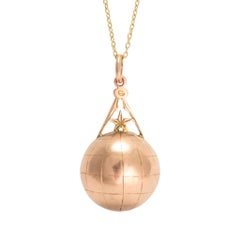Antique Gold Locket Globe
Recent Sales
Late 19th Century English Late Victorian Antique Gold Locket Globe
9k Gold
A Close Look at late-victorian Jewelry
Also called Aesthetic period jewelry, historians have determined that antique late Victorian jewelry and watches are representative of an era that lasted from about 1880 until 1901 and ushered in the Belle Époque.
Queen Victoria wore her heart on her sleeve, and her emotions were reflected in her fashion and in what we now call Victorian jewelry. By about 1880, Queen Victoria and her constituents were ready to look to the future. The dark skies were parting and fashion was changing. There was also a major shift in industry.
While in the beginning of Queen Victoria’s reign the focus was on manufacturing, toward the later years there was a renewed interest and appreciation of the handmade. The late Victorian period (1880–1901) was referred to as the Aesthetic period and coincided with these changing tastes.
The Aesthetic Movement, concerned with “art for art’s sake,” began in Britain around the 1870s and became recognized by designers and artists worldwide, eventually resulting in the Arts and Crafts movement (1880s–1920s).
Stylistically, jewelry of this time period did not resemble its earlier Victorian counterparts, in fact it was in complete opposition to what preceded it. Gone were the mourning jewelry, heavy brooches and large necklaces. Late Victorian-era jewelry was smaller, lighter and more dainty. Women still layered pieces, though, and favored smaller scatter pins. Jewelry also became an evening accessory and not so visible during the day.
Women were starting to actively participate in sporting events (socially, of course, not professionally), so athletic motifs showed up on their accessories. Lockets and heart pendants remained popular, but the REGARD or DEAREST rings of the early Victorian period were replaced by Mizpah pieces, which means “the Lord watches over me” in Hebrew. These items were exchanged between two people to symbolize a close bond.
Diamonds came into fashion, and semiprecious gems such as amethysts and opals became prevalent, too. Using gemstones for their natural beauty and not their worth was something that jewelers of the Aesthetics movement felt passionate about, and this ideology would really become relevant in Art Nouveau jewelry.
The Brits still looked to their monarchs to dictate the latest trends. Queen Victoria’s daughter-in-law Alexandra famously wore a dog-collar necklace, also known as a collier de chien, made up of multiple strands of pearls, to hide a scar. This style of necklace quickly rose to prominence. Toward the end of the 19th century, solitaire rings were also becoming fashionable thanks to Tiffany & Co.’s advent of the six-prong diamond setting in 1886. Platinum was starting to be used in jewelry production as well. Edwardian and, afterward, Art Deco engagement rings that followed in the wake of Queen Victoria’s death in 1901 would be characterized by complex geometric designs and platinum settings.
Women were the biggest influences on jewelry. They joined the workforce, fought for their independence and overall began to lead a much more active lifestyle. Jewelry had to become comfortable and serve multiple purposes. While in the United States, the Gibson Girls lifestyle was emulated by young women, and starlets became trendsetters.
Finally, the international expositions made the world seem like a much smaller place and jewelry from North Africa and India captured people’s attention, appealing to those who already favored Revival jewelry from the Etruscans to the Romans.
Find antique late Victorian jewelry and watches on 1stDibs.
Finding the Right pendant-necklaces for You
Whether you’re layering multiple jewelry pieces or opting for a single strand, vintage pendant necklaces are versatile accessories that can elevate your casual wear as easily as they can add a creative flourish to your formal attire.
The earliest jewelry was less about accessorizing than it was about wearers arming themselves with amulets. In Ancient Egypt, some amulets featured a loop so that they could be strung around one’s neck. While rubies have long been one of the few gemstones that can give diamonds a run for their money, members of some ancient civilizations valued the stones from the get-go, donning ruby pendants as well as other stones with the belief that these adornments would bring protection, healing powers or strength. Today, we still wear our charm bracelets and charm pendants around our necks for good luck.
Later, pendant necklaces, like most fine jewelry, were worn strictly by royalty or the upper class and conferred wealth and prestige. This changed over time, thankfully, as wearing jewelry became more widespread, a democratized means of personal expression.
During the 18th and 19th centuries, pendant necklaces evolved from their status as spiritual amulets, but the jewels still carried deep personal significance. Victorian pendants, in particular, were part of the “mourning jewelry” tradition. Wearers would embed their pendants with locks of hair from a deceased loved one as a way of grieving in the wake of a loss. In the case of cameo jewelry, some pendants were even decorated with miniature hand-carved portraits in a detailed raised relief. Today, portraiture is still a characteristic of many of the hand-carved pendant necklaces offered by Italian jewelry house Scala Gioielli.
Luxury fine jewelry brands such as Cartier, BVLGARI and David Yurman offer their own unique interpretations of the cherished accessory, embellishing platinum or gold pendant necklaces with diamonds, sapphires and other stones.
On 1stDibs, find an extraordinary range of vintage pendant necklaces and other necklaces today.
